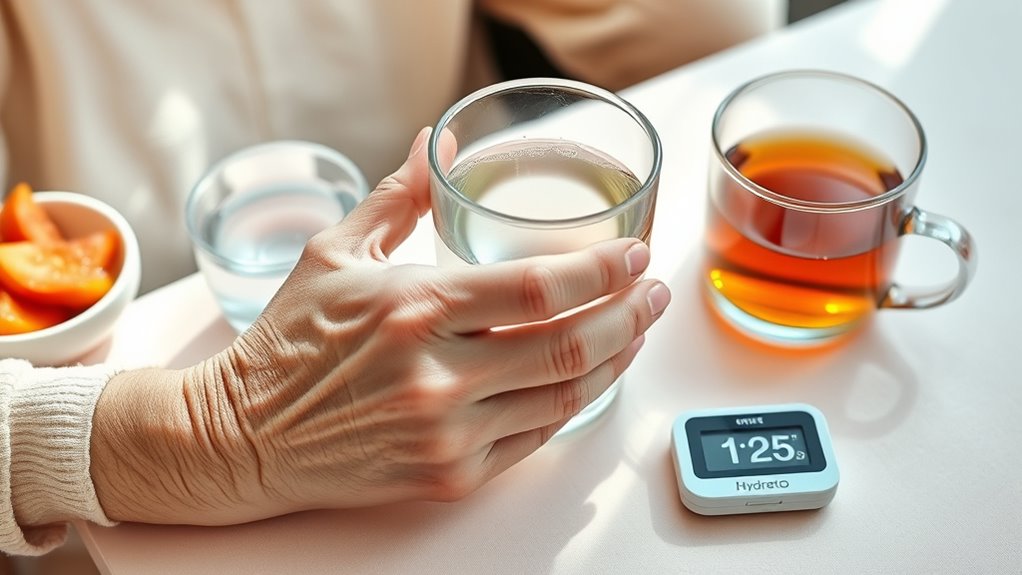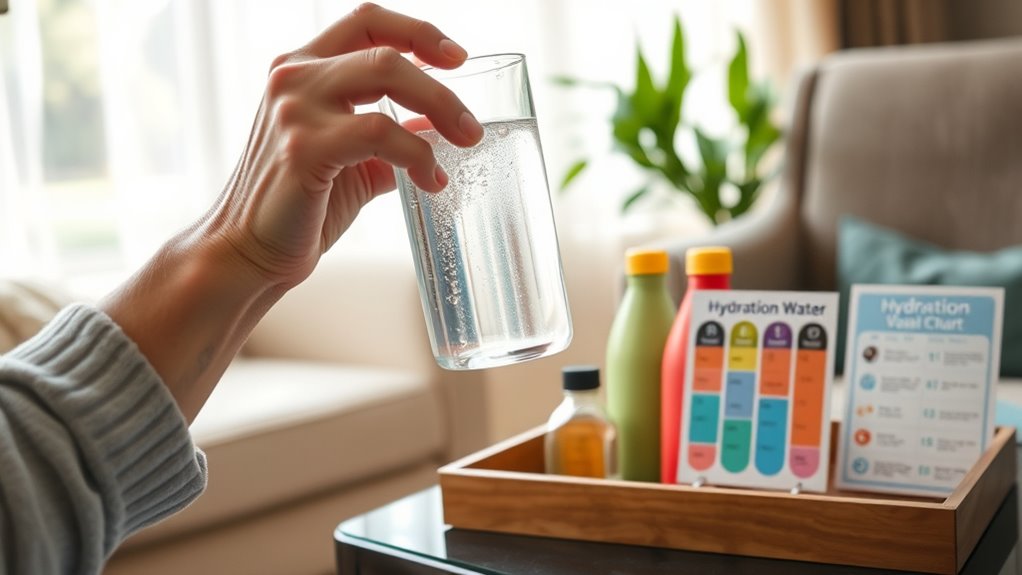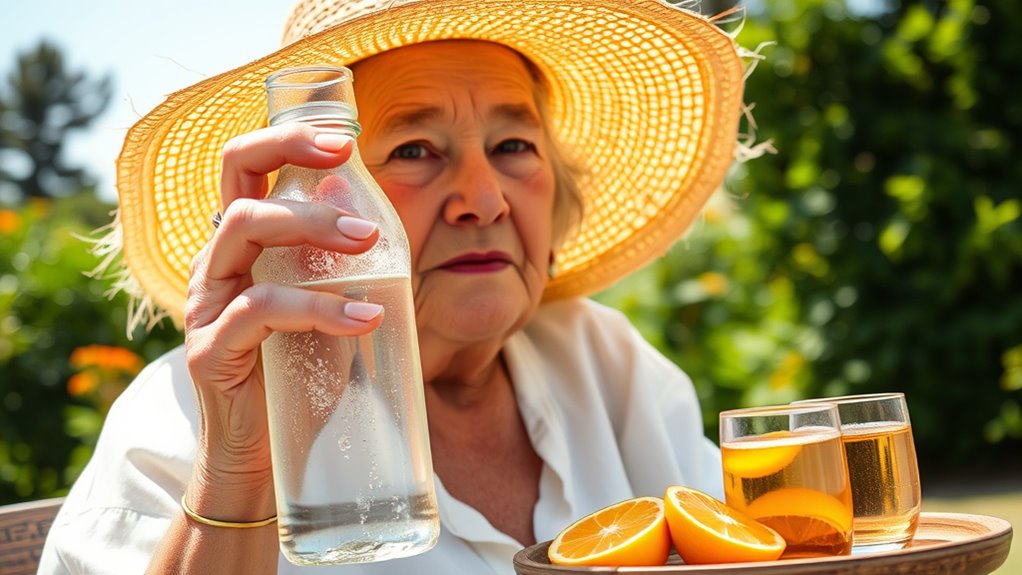To stay well-hydrated, watch for signs like dark urine, dry mouth, or fatigue, which may indicate dehydration. Enhance flavor by infusing water with fruits or herbs, and include hydrating snacks like watermelon or cucumbers. Establish a routine by drinking at set times, especially with meals, and adjust your intake based on activity level and weather. For personalized tips, explore further ways to keep your hydration on track and healthy.
Key Takeaways
- Encourage regular fluid intake through routines, such as drinking water with meals and at set times throughout the day.
- Use flavorful infusions like citrus or herbs to make water more appealing and increase consumption.
- Incorporate water-rich snacks like watermelon and cucumbers to boost hydration naturally.
- Monitor signs of dehydration, including dark urine, dry mouth, and fatigue, and adjust fluid intake accordingly.
- Consult healthcare providers for personalized hydration strategies, especially for those with health conditions or medication considerations.
Recognizing the Signs of Dehydration in Seniors

Since older adults often don’t recognize dehydration symptoms on their own, it’s important to stay alert to the signs. Dehydration can disrupt your electrolyte balance, leading to confusion, weakness, and dizziness. You might notice you’re less thirsty than usual because thirst perception diminishes with age, making it harder to recognize when your body needs fluids. Watch for dark-colored urine, dry mouth, or feeling unusually tired, as these are common indicators. Decreased electrolyte levels can cause muscle cramps or irregular heartbeat, so pay attention to any new or unusual symptoms. Staying vigilant helps ensure you catch dehydration early, preventing more serious health issues. Regularly monitoring your body’s signals is key to maintaining proper hydration and overall well-being. Incorporating hydration strategies such as drinking fluids consistently and eating water-rich foods can further support your hydration efforts. Being aware of the decline in thirst perception associated with aging can help you stay proactive about hydration. Additionally, understanding the signs of dehydration can empower you to take prompt action when needed. Recognizing the importance of digital literacy in health management can also help you access reliable information about hydration and wellness.
Incorporating Flavorful and Appealing Hydration Options

To encourage more fluid intake, making beverages both flavorful and visually appealing can make a big difference. Try infusing water with slices of citrus, berries, or herbs to add natural flavor without extra sugar. Infused water not only tastes great but also looks inviting, encouraging you to drink more. Additionally, incorporate hydrating snacks like watermelon, cucumbers, or oranges into your diet; these foods have high water content and can boost fluid intake naturally. You can prepare infused waters in advance and keep them chilled for easy access throughout the day. Regular cleaning and maintenance of your hydration tools and containers ensure safe and enjoyable drinking experiences, contributing to better hydration habits. Incorporating hydration strategies that are enjoyable can significantly improve fluid intake among elderly adults. Ensuring proper home maintenance and cleanliness can also contribute to better overall health and comfort, making hydration efforts more effective. Using hydration tracking methods can help monitor daily fluid intake and prevent dehydration. Combining flavorful drinks with hydrating snacks helps make hydration more enjoyable and appealing, ensuring you stay properly hydrated without feeling like a chore.
Establishing a Consistent Drinking Routine

Creating a regular drinking routine helps guarantee you stay consistently hydrated throughout the day. This consistency addresses common hydration challenges by making hydration a habit rather than an afterthought. To accommodate your beverage preferences, choose drinks you enjoy and find easy to consume regularly. Set specific times, like with meals or snacks, to remind yourself to drink. To visualize your routine, consider this example:
| Time of Day | Beverage Choice | Quantity |
|---|---|---|
| Morning | Glass of water | 8 oz |
| Afternoon | Herbal tea or juice | 6 oz |
| Evening | Water or milk | 8 oz |
| Bedtime | Small glass of water | 4 oz |
Establishing this pattern helps you maintain hydration effortlessly and comfortably. Regularly monitoring your hydration levels can further support your efforts. Incorporating hydration tracking tools or apps can also help you stay on top of your daily intake. Additionally, choosing nutrient-rich drinks like smoothies or infused water can make hydration more appealing and beneficial. Developing a consistent routine can effectively reinforce your hydration habits over time.
Adjusting Fluid Intake Based on Daily Activities and Weather

As you establish a regular drinking routine, it’s important to recognize that your hydration needs can change throughout the day based on your activities and the weather. When you’re more active or it’s hot outside, your body loses fluids faster, so you should increase your fluid intake to maintain electrolyte balance. Conversely, on cooler days or when you’re less active, you might need slightly less fluid. Adjust your hydration schedule accordingly—drink more during exercise or heat, and taper off when it’s cooler or you’re resting. Paying attention to your body’s signals, like thirst and the color of your urine, helps ensure proper hydration. Being aware of hydration needs can help you make better decisions about fluid intake. Incorporating mindful awareness of your body’s signals and cues can further support your hydration efforts. Flexibility in your fluid intake helps you stay balanced, comfortable, and healthy throughout the day. Additionally, understanding the role of data privacy can help you feel confident about how your health information is used and protected. Regularly monitoring your hydration status through urine color and other indicators provides valuable feedback to adjust your intake effectively. Remember that water content in foods like vegetables and fruits can also contribute to your overall hydration, especially when fluid intake is limited.
Consulting Healthcare Providers About Hydration Needs

Since hydration needs can vary greatly among individuals, consulting your healthcare provider is vital to determine the right amount of fluids for you. They can evaluate your electrolyte balance, which is essential for maintaining proper hydration and overall health. Your provider may recommend specific hydration monitoring techniques to track your fluid intake and detect signs of dehydration early. If you have underlying health conditions, such as kidney issues or heart disease, personalized guidance becomes even more important. Regular check-ins with your healthcare provider ensure you’re meeting your hydration needs safely. They can also suggest dietary adjustments or supplements if necessary. Additionally, understanding body hydration mechanisms can help you better recognize early signs of dehydration. Recognizing how your body naturally regulates fluids is crucial for maintaining proper hydration levels. Being aware of your fluid intake and how your body processes fluids is crucial for maintaining optimal hydration levels. Developing an understanding of hydration balance can further support your efforts to stay properly hydrated and prevent complications. Remember, professional advice helps prevent dehydration complications and keeps your body functioning at its best.
Frequently Asked Questions
How Much Water Should an Average Elderly Adult Drink Daily?
You should aim for about 8 cups of water daily, but individual needs vary. To stay properly hydrated, keep hydration monitoring in mind and track your fluid intake regularly. Pay attention to signs of dehydration like dry mouth or dizziness. Drinking fluids consistently, especially if you’re active or in a warm environment, helps maintain your health. Use a water bottle or journal to guarantee you meet your daily hydration goals effectively.
Are There Specific Hydration Needs for Seniors With Chronic Illnesses?
You might think all seniors need the same hydration, but chronic illness considerations change things. If you or a loved one has a condition like diabetes or heart disease, customized hydration plans become essential. These plans help prevent dehydration or overhydration, which can worsen health issues. Consult healthcare providers to tailor hydration strategies, ensuring safety and comfort, and addressing unique needs caused by chronic illnesses effectively.
Can Certain Medications Affect Hydration Levels in Elderly Adults?
Certain medications can markedly impact your hydration levels through medication side effects and drug interactions. For example, some diuretics increase fluid loss, leading to dehydration, while others might cause fluid retention. It is crucial to stay aware of how your medications affect your body’s hydration and consult your healthcare provider regularly. Monitoring symptoms and adjusting dosages can help prevent dehydration and maintain ideal hydration, especially if you’re taking multiple medications.
What Are Alternative Hydration Methods Besides Drinking Water?
Think of hydration methods like a toolbox—you’ve got options besides just drinking water. Flavor-enhanced beverages make hydration tastier, encouraging you to drink more. Hydrating foods like fruits and soups are like water reservoirs, providing moisture with every bite. These alternatives are easy ways to stay hydrated, especially if plain water feels dull or hard to swallow. Incorporate them into your routine to keep your body well-hydrated and healthy.
How Do Cognitive Impairments Influence Hydration Strategies for Seniors?
Cognitive challenges can make it harder for seniors to remember to hydrate or recognize when they’re thirsty. To improve hydration compliance, you should create simple routines, use visual cues, and encourage regular drinking schedules. Keep hydration options accessible and appealing, and monitor their intake closely. By understanding these cognitive influences, you can help ensure they stay properly hydrated, reducing risks associated with dehydration and supporting their overall well-being.
Conclusion
Staying hydrated is like tending a delicate garden—you must give your body the right amount of water to keep it thriving. By recognizing dehydration signs, choosing tasty drinks, maintaining a routine, and adjusting for daily changes, you nurture your health. Remember to consult your healthcare provider for personalized advice. With consistent care, you’ll keep your well-being blooming, ensuring your body stays as vibrant and resilient as a well-watered flower garden.









